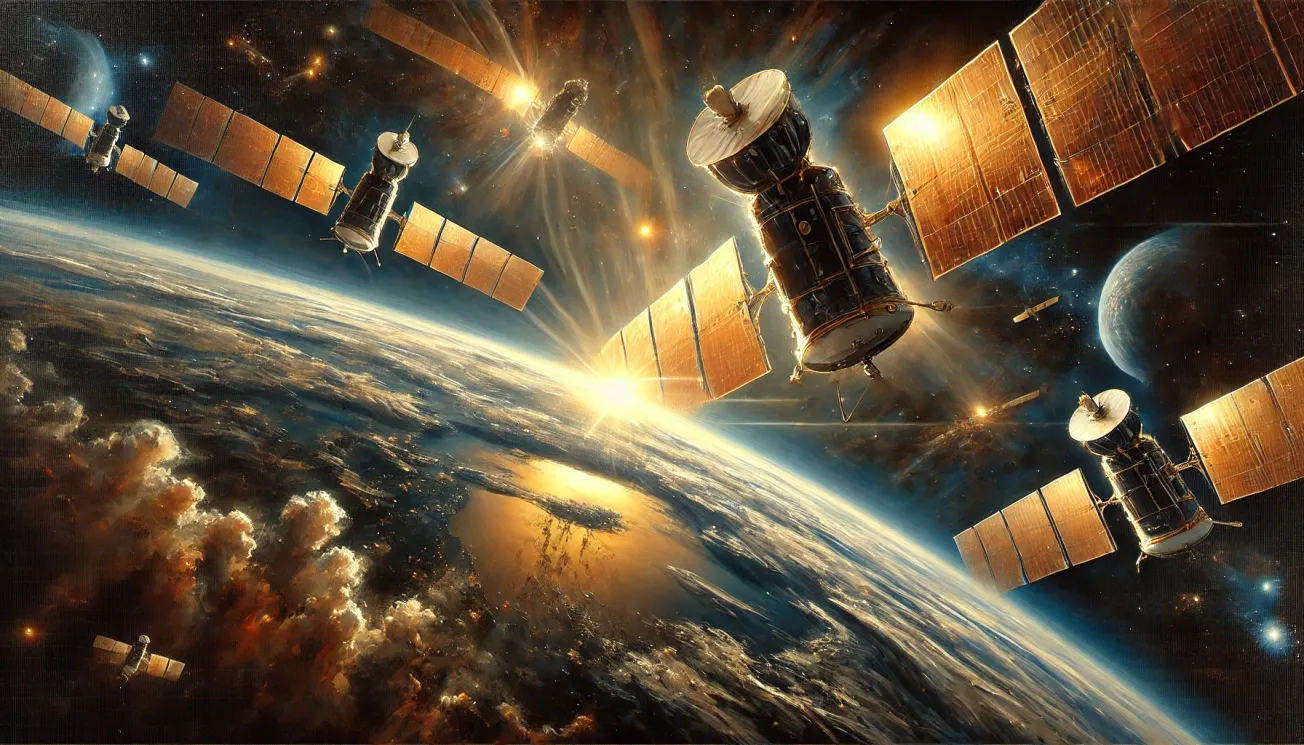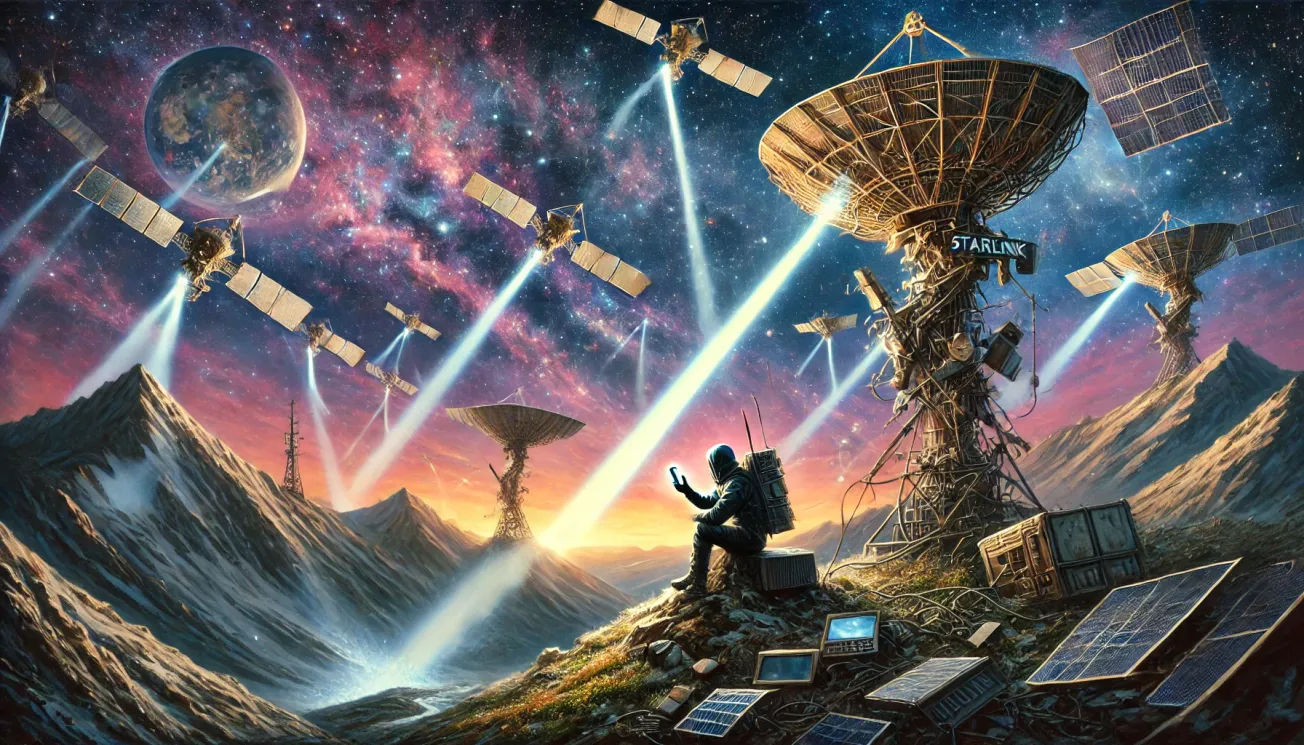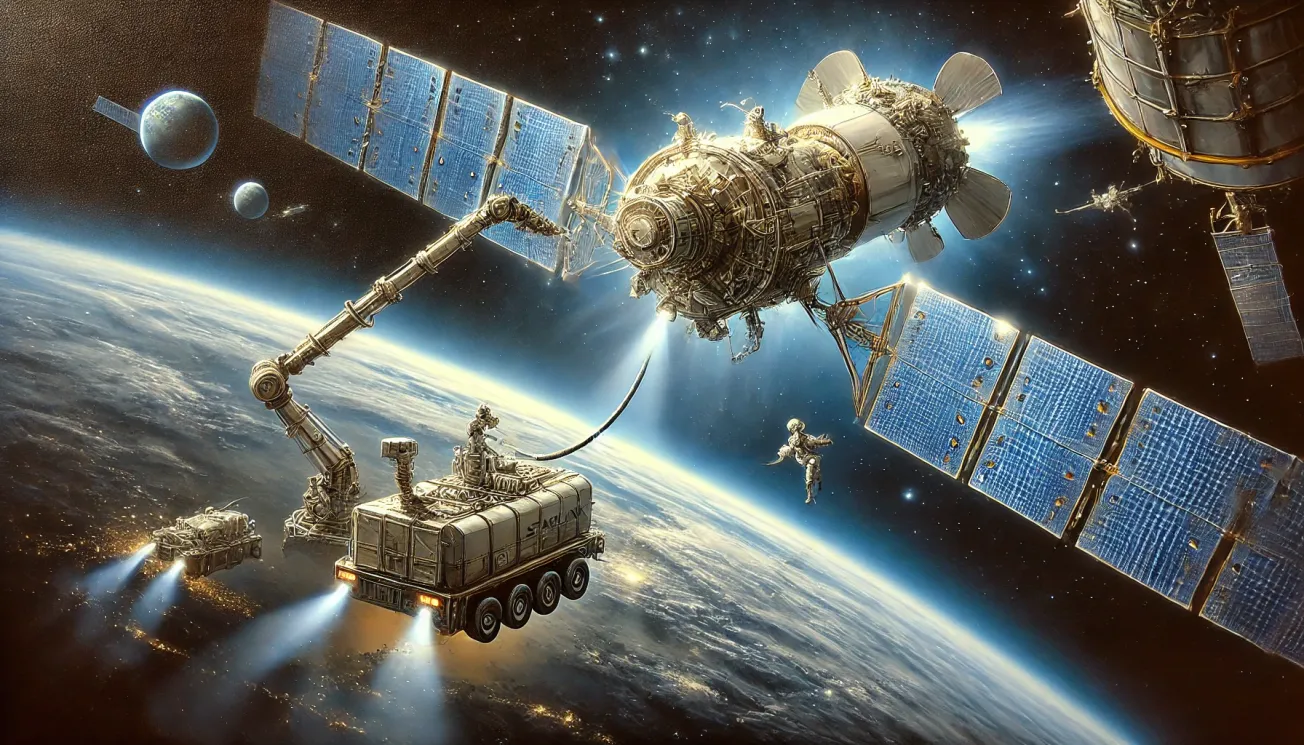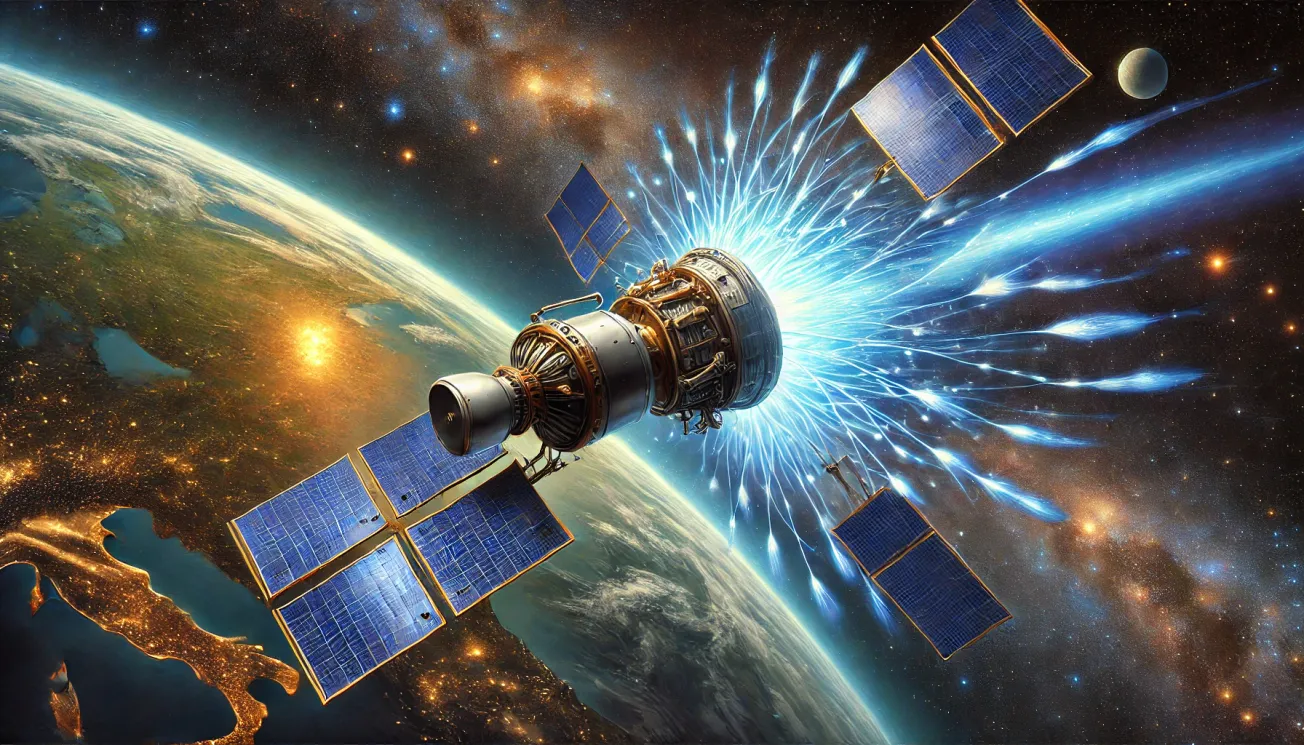Table of Contents
Introduction
In an era where global connectivity is more essential than ever, Starlink has emerged as one of the most ambitious technological projects in history. Launched by Elon Musk’s SpaceX, this satellite-based internet service aims to bridge the digital divide by providing high-speed internet access to even the most remote corners of the planet.
Unlike traditional internet service providers (ISPs) that rely on fiber-optic cables, cell towers, and ground-based infrastructure, Starlink operates through a vast network of satellites in low Earth orbit (LEO). These satellites form a mega-constellation, beaming internet signals directly to users via small, dish-like receivers.
From rural communities lacking broadband access to military and emergency services operating in disconnected regions, Starlink has positioned itself as a game-changer in the telecommunications industry. However, its rapid expansion has also sparked debates about its impact on space congestion, astronomy, and competition in the satellite industry.
What This Article Covers
In this deep dive, we’ll explore:
✔ The history of Starlink and how it grew from an idea to a dominating force in space
✔ The scale of its satellite network today and its plans for the future
✔ How the satellites are launched and maintained
✔ Whether Starlink is causing problems for astronomers and space agencies
✔ How to see and track Starlink satellites in the night sky
✔ The growing concerns over space debris and competition
By the end of this article, you’ll have a comprehensive understanding of how Starlink is reshaping both the internet and outer space—for better or worse.
The History of Starlink
From Vision to Reality: How Starlink Was Born
The origins of Starlink can be traced back to Elon Musk’s broader vision of space exploration and global connectivity. While SpaceX was initially focused on reducing the cost of space travel and developing rockets for interplanetary missions, Musk recognized that a global satellite internet network could serve both Earth and future Mars colonies.
The idea gained momentum in 2015, when SpaceX officially announced its plans to develop a satellite-based broadband network. The goal? To provide high-speed internet access worldwide, especially in areas with poor or no connectivity. Unlike traditional satellite internet providers, which relied on small fleets of geostationary satellites positioned 35,000 km (22,000 miles) above Earth, Starlink would deploy thousands of satellites in low Earth orbit (LEO) between 340 km and 550 km (210-340 miles) high—dramatically reducing latency and improving performance.
Early Development and First Launches
SpaceX began working on prototype satellites in the mid-2010s, conducting its first public tests in 2018 with Tintin A and Tintin B, two experimental satellites launched aboard a Falcon 9 rocket. These tests proved successful, demonstrating that LEO-based satellites could provide low-latency, high-speed internet access.
The first full-fledged batch of 60 Starlink satellites was launched on May 23, 2019, marking the beginning of what would become the largest satellite constellation ever deployed.
Rapid Expansion and Milestones
After its initial launch, Starlink entered an aggressive deployment phase, leveraging SpaceX’s reusable Falcon 9 rockets to send 50–60 satellites into orbit per launch. Key milestones in Starlink’s growth include:
- 2020: Starlink began beta testing under the program “Better Than Nothing Beta,” allowing early adopters to try the service.
- 2021: The network expanded beyond North America, reaching Europe, Australia, and parts of Asia. SpaceX also introduced laser inter-satellite links, improving coverage and reducing the need for ground stations.
- 2022: The service played a crucial role in Ukraine’s defense efforts by providing internet connectivity during the Russian invasion, demonstrating Starlink’s strategic importance.
- 2023: Starlink launched its Direct-to-Cell initiative, aiming to provide satellite-based mobile coverage to standard smartphones.
- 2024: The constellation surpassed 7,000 active satellites, far outpacing competitors like OneWeb and Amazon’s Project Kuiper.
Current Status and Future Goals
As of 2025, Starlink is the undisputed leader in satellite-based broadband, with plans to deploy tens of thousands more satellites in the coming years. SpaceX has obtained approval for 12,000 satellites and is seeking permission for up to 42,000—a staggering number that could reshape the future of space-based internet.
However, this rapid expansion has also sparked controversy, with concerns about space debris, satellite congestion, and light pollution for astronomers. These issues will be explored in later sections, but one thing is clear: Starlink has fundamentally changed the satellite industry, bringing both innovation and challenges.
How Many Satellites Does Starlink Have?
As of March 15, 2025, SpaceX's Starlink constellation comprises approximately 7,095 satellites in orbit, with 7,061 of them operational.
The most recent launch occurred on March 15, 2025, when a Falcon 9 rocket successfully deployed 23 Starlink satellites.
This rapid deployment has solidified Starlink's position as the largest satellite constellation in history, far surpassing other satellite networks. For context, the total number of active satellites from all other operators combined is significantly lower, highlighting Starlink's dominant presence in low Earth orbit.
The sheer scale of Starlink's constellation has not only transformed global internet connectivity but also raised discussions about space traffic management and the long-term sustainability of satellite operations. As SpaceX continues to expand its network, these considerations remain at the forefront of industry and regulatory conversations.
Starlink’s Long-Term Plans
SpaceX's Starlink project has outlined ambitious plans to expand its satellite constellation significantly:
- Initial Authorization: The Federal Communications Commission (FCC) has granted SpaceX approval to deploy nearly 12,000 satellites into low Earth orbit (LEO).
- Proposed Expansion: SpaceX has filed requests with the FCC to launch an additional 30,000 satellites, aiming for a total of 42,000 satellites in its constellation.
These expansions are intended to enhance global internet coverage, reduce latency, and increase network capacity, ensuring that even the most remote regions have access to high-speed internet services.
How Starlink Satellites Are Launched
SpaceX's Falcon 9 rocket serves as the primary vehicle for deploying Starlink satellites into low Earth orbit (LEO). This two-stage rocket is renowned for its reusability and reliability, making it integral to the rapid expansion of the Starlink constellation.
Number of Satellites per Launch
Each Falcon 9 mission typically carries between 21 to 23 Starlink satellites, depending on the satellite variant and mission requirements. For instance, the Starlink 12-25 mission, scheduled for March 18, 2025, aims to deploy 23 satellites, including 13 equipped with Direct-to-Cell capabilities.
Launch Schedule for 2025
In 2025, SpaceX plans to maintain an aggressive launch cadence to further populate its Starlink constellation. While the exact number of launches is subject to change based on various factors, the company has demonstrated the capability to conduct multiple launches within short intervals. For example, on March 15, 2025, SpaceX successfully launched 23 Starlink satellites aboard a Falcon 9 rocket.
This rapid deployment strategy underscores SpaceX's commitment to providing global internet coverage and enhancing the capacity and reliability of the Starlink network.
Starlink Satellite Design & Capabilities
Starlink satellites, developed by SpaceX, have undergone significant advancements in design and functionality to deliver global internet coverage effectively. Here's an overview of their key specifications:
Size and Weight
- First-Generation Satellites (Version 1.0): Each satellite weighed approximately 260 kg (573 lbs).
- Current-Generation Satellites (Version 2.0 Mini): The latest iteration has increased in size and mass, with each satellite weighing around 800 kg (1,760 lbs). This substantial increase accommodates advanced technologies and improved capabilities.
Power Sources
- Solar Panels: Starlink satellites are equipped with solar arrays that harness sunlight to generate the necessary power for operations.
- Batteries: To ensure continuous functionality during periods when the satellites are in Earth's shadow, they are fitted with onboard batteries. While the exact battery capacity in amp-hours (Ah) for Starlink satellites has not been publicly disclosed by SpaceX, these batteries store excess energy generated by the solar panels, allowing uninterrupted service.
Propulsion System
- Hall-Effect Thrusters: For orbital adjustments and maintaining their designated positions, Starlink satellites utilize Hall-effect thrusters. These ion propulsion systems expel ionized gas to produce thrust.
- Propellant: While traditional satellites often use xenon as the propellant for ion thrusters, Starlink satellites employ krypton. Although krypton offers slightly lower performance compared to xenon, it is more cost-effective, aligning with SpaceX's goal of reducing expenses.
Cost Considerations
SpaceX has not publicly disclosed the exact manufacturing cost per Starlink satellite. However, the company has consistently emphasized cost-efficiency in both satellite production and launch operations. By leveraging reusable launch vehicles and streamlining manufacturing processes, SpaceX aims to make global satellite internet both accessible and economically viable.
Starlink Satellites: Lifespan and Space Debris Management
As SpaceX's Starlink constellation expands, understanding the operational lifespan of these satellites and the measures in place to manage space debris becomes increasingly important.
Operational Lifespan
Starlink satellites are designed with an operational lifespan of approximately five years. This relatively short duration allows SpaceX to continually update the constellation with newer technologies, enhancing performance and service capabilities. Operating in low Earth orbit (LEO), these satellites experience atmospheric drag, which naturally contributes to their deorbiting process over time.
Space Debris Mitigation Strategies
To address the growing concern of space debris, SpaceX has implemented several proactive measures:
- Autonomous Collision Avoidance: Starlink satellites are equipped with an automated collision avoidance system that utilizes data from the U.S. Department of Defense's debris tracking system. This enables the satellites to autonomously assess risks and execute maneuvers to prevent potential collisions without human intervention.
- Controlled Deorbiting: At the end of their operational life or in cases of malfunction, Starlink satellites are programmed to deorbit in a controlled manner. Using their onboard propulsion systems, they re-enter Earth's atmosphere, where they are designed to burn up completely, leaving no debris.
- Natural Deorbiting: Satellites operating below 600 km altitude are subject to atmospheric drag, which will naturally deorbit a satellite in five years or less, depending on the altitude and satellite design, should one fail on orbit.
Challenges and Ongoing Efforts
Despite these measures, the increasing number of satellites in LEO raises concerns about space congestion and the potential for collisions:
- Near-Miss Incidents: Reports indicate that Starlink satellites have been involved in numerous near-miss events, highlighting the challenges of managing a large satellite constellation.
- International Collaboration: SpaceX is in discussions with organizations like the European Space Agency (ESA) to enhance debris mitigation efforts. The ESA's Zero Debris Charter, aiming to eliminate new orbital debris by 2030, represents a collaborative approach to addressing this global issue.
By implementing these strategies and engaging in international cooperation, SpaceX aims to minimize the environmental impact of its Starlink constellation and promote the sustainable use of outer space.
Starlink Satellites That Are Not Working
With thousands of Starlink satellites orbiting Earth, not all of them remain fully operational throughout their lifespan. Some satellites experience malfunctions or failures, prompting concerns about what happens to them and how they are managed.
Percentage of Non-Functional Starlink Satellites
SpaceX maintains a high success rate with its Starlink satellites, but as with any large-scale technological project, some failures occur. Estimates suggest that around 2-5% of Starlink satellites become non-functional at some point. Given the total number of satellites in orbit, this means that over 140 to 350 satellites may currently be inactive.
Why Do Some Satellites Fail?
Several factors contribute to Starlink satellites becoming non-functional:
- Software or Hardware Malfunctions – Starlink satellites rely on sophisticated onboard computing systems, and while SpaceX frequently updates its software remotely, some failures cannot be resolved.
- Power System Failures – If a satellite's solar panels or battery systems are damaged or malfunction, it may lose the ability to power its communications and propulsion systems.
- Collisions or Damage from Space Debris – While Starlink satellites have collision avoidance systems, the growing amount of debris in low Earth orbit poses an increasing risk. Even small impacts can disable a satellite.
- Propulsion System Malfunctions – Starlink satellites rely on Hall-effect thrusters powered by krypton gas to adjust their orbits. If a thruster fails, the satellite may drift out of position and become unusable.
How Long Do Non-Functional Satellites Remain in Orbit?
The duration a non-functional Starlink satellite remains in orbit depends on its altitude and whether it retains any control systems.
- Lower-Orbit Satellites (Below 550 km) – Satellites at these altitudes experience natural orbital decay due to atmospheric drag. If a failed satellite cannot adjust its trajectory, it will typically deorbit within 1 to 5 years, burning up in Earth’s atmosphere.
- Higher-Orbit Satellites (Above 600 km) – If a satellite is placed at a higher altitude (e.g., during testing or early phases of deployment), the deorbiting process could take much longer. However, SpaceX has committed to launching Starlink satellites in orbits that will naturally decay over time, reducing long-term space debris risks.
What Happens to Starlink Satellites That Stop Working?
SpaceX has two primary ways of dealing with non-functional satellites:
- Controlled Deorbiting – If a satellite loses function but retains some operational capability, SpaceX can remotely command it to deorbit using its remaining propulsion system. This ensures it burns up in Earth’s atmosphere without leaving debris behind.
- Natural Decay – If the propulsion system fails completely, the satellite remains in orbit until atmospheric drag gradually pulls it down. At Starlink’s low altitudes, this usually occurs within a few years.
Are Failed Satellites a Major Issue?
While hundreds of satellites becoming non-functional is not insignificant, SpaceX's strategy of operating at lower altitudes and ensuring natural deorbiting helps mitigate long-term debris risks. However, the increasing number of satellites in space raises concerns about future congestion and potential collisions, making satellite management an ongoing challenge.
Power and Fuel Requirements of Starlink Satellites
Starlink satellites rely on a combination of solar power and onboard propulsion systems to maintain their operations, adjust their orbits, and eventually deorbit at the end of their lifespan. Understanding how these systems work sheds light on the energy efficiency and longevity of the constellation.
How Do Starlink Satellites Generate Power?
Starlink satellites are entirely solar-powered, using a single large solar array to generate electricity. This energy powers the satellite’s communication systems, computers, and propulsion.
- Solar Panel Size & Efficiency – Each satellite is equipped with a high-efficiency solar panel that unfolds after deployment. The exact size of these panels is undisclosed, but they are optimized for maximum energy capture in low Earth orbit (LEO).
- Power Output – Each satellite generates between 2 and 3 kilowatts of power, enough to sustain continuous operations, including data transmission and navigation.
Battery Capacity and Storage
To ensure continuous functionality, Starlink satellites are equipped with onboard rechargeable lithium-ion batteries that store excess energy collected from the solar panels.
- Battery Capacity – While exact amp-hour (Ah) specifications are not publicly available, estimates suggest a range of 80-100 Ah per satellite, allowing them to function for extended periods when not exposed to sunlight.
- Role of Batteries – These batteries keep the satellite running when it passes through Earth’s shadow, ensuring uninterrupted service.
What Fuel Do Starlink Satellites Use?
Unlike traditional satellites that rely on large fuel tanks and chemical thrusters, Starlink satellites use electric propulsion in the form of Hall-effect thrusters powered by krypton gas.
- Why Krypton Instead of Xenon? – Most other satellites use xenon for ion propulsion, but SpaceX opted for krypton because it is cheaper and more abundant, reducing operational costs while maintaining adequate performance.
- Propellant Storage – Each satellite carries several kilograms of krypton, enough to sustain its orbital adjustments for its entire operational lifespan (approximately five years).
- Efficiency – Hall-effect thrusters are highly efficient, using small amounts of krypton to generate steady thrust, allowing precise maneuvering with minimal fuel consumption.
How Long Will the Fuel Last?
The krypton propulsion system is designed to last for the satellite’s full operational life of around five years. However, fuel consumption depends on various factors:
- Station-Keeping – Satellites regularly use their thrusters to counteract atmospheric drag and stay in their intended orbits.
- Collision Avoidance – If an object is detected on a potential collision path, a satellite may use extra fuel to move out of the way.
- Deorbiting Process – Once a satellite reaches the end of its life, it can use remaining fuel to lower its orbit, allowing atmospheric drag to complete the deorbiting process faster.
What Happens When the Fuel Runs Out?
Once a Starlink satellite depletes its krypton reserves, it can no longer adjust its orbit or avoid collisions. However, because all Starlink satellites operate in relatively low orbits, they will naturally re-enter Earth’s atmosphere and burn up within a few years.
How Starlink Satellites Are Launched
Launching Starlink satellites is a meticulously planned and highly efficient process, allowing SpaceX to deploy dozens of satellites at a time while keeping costs low. The launch system relies on the Falcon 9 rocket, a reusable two-stage launch vehicle designed to carry Starlink payloads into low Earth orbit (LEO).
Step-by-Step Breakdown of a Starlink Satellite Launch
- Pre-Launch Preparations
- The Starlink satellites are stacked horizontally inside the payload fairing of the Falcon 9 rocket. Unlike traditional satellites, which are often deployed individually or in small clusters, SpaceX maximizes payload capacity by stacking them in a "flat-pack" configuration, reducing wasted space.
- Each launch typically carries 21-23 satellites (for the latest Starlink V2 Mini versions), with earlier versions launching up to 60 satellites per mission.
- Rocket Propellant Loading
- The Falcon 9 is fueled with RP-1 (refined kerosene) and liquid oxygen (LOX).
- About 35 minutes before liftoff, the rocket begins "chilling" its engines by flowing small amounts of supercooled liquid oxygen to prepare for ignition.
- Liftoff
- Falcon 9 ignites its nine Merlin engines, producing 1.7 million pounds of thrust, lifting off from one of SpaceX’s launch sites:
- Kennedy Space Center (Florida)
- Cape Canaveral Space Force Station (Florida)
- Vandenberg Space Force Base (California)
- Falcon 9 ignites its nine Merlin engines, producing 1.7 million pounds of thrust, lifting off from one of SpaceX’s launch sites:
- Stage Separation
- Around 2.5 minutes after launch, the first stage (booster) separates and begins its return journey to Earth.
- The second stage ignites its single Merlin Vacuum (MVac) engine, which carries the satellites into orbit.
- Fairing Deployment
- The payload fairing, which protects the satellites during launch, is jettisoned once the rocket reaches space. SpaceX retrieves and reuses these fairings to save costs.
- First Stage Landing
- Meanwhile, the first stage booster executes a controlled landing on a drone ship stationed in the ocean or at a landing pad near the launch site. This reusability significantly reduces launch costs.
- Second Stage Burn & Orbit Insertion
- The second stage continues firing its engine until reaching the desired deployment altitude (typically between 340 km and 550 km above Earth).
- Satellite Deployment
- Unlike traditional satellites, Starlink satellites do not use spring-loaded mechanisms or robotic arms for deployment.
- Instead, the entire payload stack is gently released at once, allowing the satellites to gradually drift apart using tiny reaction control thrusters.
- Orbit Raising & Activation
- After deployment, each satellite:
- Deploys its single solar array for power generation.
- Uses krypton-powered Hall-effect thrusters to reach its final operational altitude.
- Begins communication tests with ground stations.
- After deployment, each satellite:
- Final Integration into the Starlink Network
- Once a satellite reaches its designated orbit, it becomes fully operational, linking up with other satellites via laser interconnects and relaying internet data.
How Often Does SpaceX Launch Starlink Missions?
- SpaceX regularly launches Starlink satellites, often multiple times per month.
- The company holds the record for fastest turnaround time between two Falcon 9 launches, sometimes launching three Starlink missions within 48 hours.
- As of 2025, SpaceX plans to launch over 200 Starlink missions per year, significantly expanding its mega-constellation.
Why Is This Launch Process So Efficient?
- Flat-pack satellite design allows for rapid deployment.
- Reusable boosters and fairings significantly cut costs.
- Multiple launch sites provide flexibility for high-frequency launches.
- Autonomous navigation and collision avoidance reduce human oversight requirements post-launch.
Starlink’s Competition: Who Else Is in the Race?
While Starlink is currently the dominant satellite internet provider, it is not the only player in the industry. Several companies and governments are developing their own satellite constellations to compete with SpaceX. These competitors range from existing networks to ambitious new projects aiming to challenge Starlink’s global presence.
Who Are Starlink’s Biggest Competitors?
1. OneWeb (UK-based, backed by Eutelsat & the UK Government)
- Number of satellites: ~640 (much smaller than Starlink)
- Current status: Operational but not yet global
- Orbit altitude: ~1,200 km (higher than Starlink)
- Strengths:
- Partnership with European governments and businesses
- Focus on enterprise and government contracts rather than residential service
- Challenges:
- Smaller network leads to higher latency than Starlink
- Lacks direct consumer service, instead working with internet service providers
2. Amazon’s Project Kuiper
- Number of planned satellites: 3,236 (much smaller than Starlink but growing)
- Current status: First test satellites launched in 2023; commercial service expected by 2026
- Orbit altitude: ~590 km (similar to Starlink)
- Strengths:
- Amazon’s massive infrastructure & cloud services (AWS) integration
- Potential for seamless integration with Amazon Echo, Fire TV, and Alexa devices
- Challenges:
- Several years behind Starlink in deployment
- No live customer service yet
3. Telesat Lightspeed (Canada-based, enterprise-focused)
- Number of planned satellites: 198 (focused on business users, not consumers)
- Current status: Scheduled for 2026 launch
- Orbit altitude: ~1,000 km
- Strengths:
- Government and military contracts
- Business and enterprise-focused services
- Challenges:
- No direct competition with Starlink for home internet
- Small constellation compared to Starlink’s thousands of satellites
4. China’s “Guowang” Mega-Constellation
- Number of planned satellites: 13,000+ (major competitor to Starlink)
- Current status: In early development, aiming for mass deployment by 2030
- Strengths:
- Government-backed, fully state-controlled
- Focus on domestic and international markets to rival Starlink’s global coverage
- Challenges:
- Regulatory and geopolitical barriers
- Could be restricted in certain markets
5. AST SpaceMobile (Direct-to-Mobile Satellite Internet)
- Number of planned satellites: 100+ (low count but unique service)
- Current status: Successfully tested satellite-to-smartphone broadband in 2023
- Strengths:
- Does not require a dish—connects directly to standard smartphones
- Could be a game-changer for cellular dead zones and rural connectivity
- Challenges:
- Still in development, not yet widely available
- Different focus than Starlink (mobile broadband rather than home/enterprise service)
Will the Skies Become Too Crowded?
With thousands of satellites being launched every year, concerns about orbital congestion and collision risks are increasing. Some key issues include:
✔ Satellite Traffic Management – With so many companies launching satellites, experts worry about potential collisions and interference between different constellations.
✔ Light Pollution & Astronomy Disruptions – More satellites mean more reflections in the night sky, interfering with astronomical observations.
✔ Space Debris Risks – A failed satellite or collision could trigger a chain reaction, creating thousands of new debris fragments (known as the Kessler Syndrome).
✔ Regulatory Oversight – Right now, satellite launches are mostly regulated by national agencies like the FCC (U.S.), ITU (International Telecommunication Union), and national space agencies. But with private companies launching satellites at an unprecedented pace, experts argue that new international regulations may be needed.
Who Regulates Space? Are There Restrictions on Satellite Orbits?
- The FCC (Federal Communications Commission) regulates U.S.-based satellite operators like Starlink and Project Kuiper.
- The ITU (International Telecommunication Union) coordinates satellite spectrum and orbits globally.
- National Governments regulate their own space programs, such as China’s Guowang network and the EU’s IRIS² satellite program.
- Altitude restrictions are primarily based on minimizing collision risks, ensuring satellites don’t interfere with other space assets.
Currently, there are no strict international laws limiting the number of satellites a company can launch, but increasing congestion could force new global agreements on orbital management in the near future.
Conclusion: Can Starlink Maintain Its Lead?
Despite growing competition, Starlink remains years ahead of its rivals in deployment and user adoption. While Amazon’s Project Kuiper and China’s Guowang constellation may challenge SpaceX in the long term, no company currently has the same scale, launch efficiency, or global reach as Starlink.
However, the next decade will determine whether Starlink’s dominance continues—or whether the satellite internet market becomes more competitive.
How Starlink Satellites Maintain Their Orbit and Altitude
Starlink satellites operate at low Earth orbit (LEO), meaning they are much closer to Earth than traditional satellites. To stay in position and function properly, they rely on a combination of precise altitude control, onboard propulsion, and automated orbital adjustments.
What is the Correct Altitude for Starlink Satellites?
Starlink satellites typically orbit at 550 km (342 miles) above Earth, though some operate at higher altitudes between 340 km and 570 km.
✔ Why Such a Low Orbit?
- Lower orbits reduce latency, making Starlink’s internet faster than traditional satellite services.
- Satellites in LEO require less power to communicate with ground stations.
- If a satellite fails, it naturally deorbits faster, reducing long-term space debris concerns.
✔ How Does This Compare to Other Satellites?
- Traditional geostationary satellites (e.g., HughesNet, ViaSat) orbit at 35,786 km (22,236 miles), leading to high latency (~600 ms vs. Starlink’s ~20-40 ms).
- GPS satellites orbit at 20,200 km (12,550 miles) to provide global positioning services.
- OneWeb and Project Kuiper satellites orbit slightly higher than Starlink, between 600 km and 1,200 km.
How Do Starlink Satellites Stay at the Right Altitude?
Once deployed, Starlink satellites do not stay in their initial position—they must actively adjust their orbits to maintain stability and avoid drifting.
1. Initial Orbit Raising
- After launch, satellites start at a lower altitude (~300 km) and use their Hall-effect thrusters (krypton-powered ion propulsion) to reach their target orbit.
- This process takes weeks to months, depending on launch conditions.
2. Station-Keeping & Orbital Adjustments
- Starlink satellites are constantly counteracting Earth’s gravitational pull and atmospheric drag using their thrusters.
- They make small, precise adjustments to stay in the correct position within the constellation.
3. Collision Avoidance
- Satellites use autonomous AI-based systems to detect potential collisions.
- If another object is on a collision course, Starlink satellites automatically adjust their position, using data from the U.S. Space Force’s space debris tracking system.
What Happens If a Satellite Drifts or Malfunctions?
If a satellite loses control of its orbit, one of two things happens:
- Controlled Deorbiting: If the satellite is still functional, SpaceX will use remaining fuel to guide it into Earth’s atmosphere, where it burns up.
- Natural Deorbiting: If it is completely non-functional, atmospheric drag will slowly pull it down over a period of 1-5 years.
Challenges in Maintaining a Large Constellation
✔ Atmospheric Drag: Even at 550 km, there is still a thin layer of Earth’s atmosphere, which slows down satellites over time.
✔ Space Congestion: More satellites mean higher risks of accidental collisions and orbital adjustments must be constantly calculated.
✔ Fuel Efficiency: Satellites have a limited supply of krypton, meaning they must balance propulsion usage carefully to extend their operational life.
Conclusion
Starlink satellites operate much closer to Earth than traditional satellites, enabling faster internet speeds but requiring constant orbital adjustments. Their automated propulsion systems and AI-driven station-keeping allow them to maintain precise positioning while avoiding collisions. However, as more satellites enter orbit, managing their placement will become increasingly complex.
Other Types of Satellites in Orbit: How Do They Compare to Starlink?
While Starlink is one of the most well-known satellite constellations today, it is just one of thousands of satellites orbiting Earth. Different satellites serve different functions, from weather forecasting to GPS navigation and military surveillance. In this section, we’ll explore the various types of satellites, their operators, and how they compare to Starlink.
How Many Satellites Are in Orbit?
As of 2025, there are approximately 10,500 active satellites orbiting Earth. Starlink alone accounts for over 7,000 of them, meaning it makes up nearly two-thirds of all satellites currently in space.
However, thousands of other satellites serve entirely different purposes and operate in different orbits than Starlink.
Types of Satellites and Their Functions
1. Communications Satellites (Starlink’s Main Category)
✔ Purpose: Provide internet, television, and telecommunication services globally.
✔ Operators: Starlink (SpaceX), OneWeb, Amazon’s Project Kuiper, Eutelsat, Viasat, HughesNet.
✔ Orbits:
- Low Earth Orbit (LEO) ~550 km (Starlink, OneWeb) → Low latency, high-speed broadband.
- Geostationary Orbit (GEO) ~35,786 km (Viasat, HughesNet) → Covers large areas but has higher latency.
✔ Comparison to Starlink: Starlink’s advantage is its low-latency broadband, whereas traditional GEO satellites have better coverage per satellite but slower speeds due to their high orbit.
2. GPS / Navigation Satellites
✔ Purpose: Provide location services for GPS, aviation, and military applications.
✔ Operators:
- United States: GPS (Global Positioning System)
- Russia: GLONASS
- European Union: Galileo
- China: BeiDou
✔ Orbits: Medium Earth Orbit (MEO) ~20,200 km
✔ Comparison to Starlink: Unlike Starlink, GPS satellites do not provide internet—they send precise timing signals that help devices determine location.
3. Earth Observation & Weather Satellites
✔ Purpose: Monitor weather, climate change, and environmental conditions.
✔ Operators:
- NASA (U.S.) – Landsat, GOES, Terra
- ESA (Europe) – Sentinel, METOP
- NOAA (U.S.) – GOES (Geostationary Operational Environmental Satellite)
- Japan, Russia, India, China also have weather satellites
✔ Orbits: - Low Earth Orbit (LEO) ~500-800 km (detailed imaging, high resolution)
- Geostationary Orbit (GEO) ~35,786 km (continuous Earth monitoring)
✔ Comparison to Starlink: Weather satellites do not provide broadband—instead, they capture high-resolution images of weather patterns, hurricanes, and climate changes.
4. Military & Surveillance Satellites
✔ Purpose: Spy satellites, missile detection, and secure military communication.
✔ Operators:
- U.S. Military & Intelligence Agencies (NRO, NSA, Air Force, Space Force)
- Russia, China, UK, France, Israel, India all operate classified satellites
✔ Orbits: - Low Earth Orbit (LEO) ~300-1,200 km (surveillance, high detail)
- Highly Elliptical Orbits (spying on specific regions for extended periods)
✔ Comparison to Starlink: While Starlink is a commercial broadband network, military satellites are classified and used for national security purposes such as spying, missile tracking, and encrypted communications.
5. Deep Space Satellites & Space Probes
✔ Purpose: Explore other planets, asteroids, and the outer solar system.
✔ Operators: NASA, ESA, China’s CNSA, Russia’s Roscosmos, India’s ISRO, Japan’s JAXA.
✔ Examples:
- Voyager 1 & 2 – Studying interstellar space.
- James Webb Space Telescope – Studying distant galaxies.
- Mars Rovers & Orbiters – Exploring the Martian surface.
✔ Comparison to Starlink: Unlike Starlink, these satellites do not orbit Earth—they are sent millions of kilometers into deep space.
Who Owns and Operates Most Satellites?
1️⃣ Starlink (SpaceX) – Over 7,000 satellites
2️⃣ U.S. Military & Government – Hundreds of classified satellites
3️⃣ NASA & ESA – Earth observation and deep space missions
4️⃣ OneWeb & Amazon’s Kuiper – Growing broadband constellations
5️⃣ Weather & Science Agencies – Hundreds of satellites for climate research
Conclusion: How Starlink Fits Into the Satellite Landscape
Starlink dominates in numbers, but it is just one category of satellites.
✔ Traditional satellites (weather, GPS, military) serve specialized functions that Starlink does not replace.
✔ Other broadband networks (OneWeb, Kuiper) compete with Starlink, but none are at the same scale yet.
✔ New space regulations may be needed as more companies launch large constellations into orbit.
Conclusion: The Future of Starlink and Satellite Communications
Starlink has transformed the satellite industry, rapidly becoming the largest constellation ever deployed and offering high-speed internet to remote and underserved areas worldwide. However, its dominance comes with both opportunities and challenges that will shape the future of space-based communications.
Key Takeaways
✔ Starlink is the largest satellite network in history
- Over 7,000 satellites in orbit, with plans to expand to 42,000 in the future.
- Rapid expansion is driven by SpaceX’s reusable rockets, which allow frequent and cost-effective launches.
✔ Competition is growing, but Starlink is still ahead
- OneWeb, Amazon’s Project Kuiper, and China’s Guowang are building their own satellite constellations, but none have reached Starlink’s scale yet.
- Regulatory agencies may impose new limits on satellite launches due to growing concerns about congestion and space debris.
✔ Satellite internet is becoming a major force in global connectivity
- Traditional internet providers (fiber, cable, DSL) do not reach rural areas, but Starlink and its competitors are filling the gap.
- Starlink is especially useful for military operations, emergency response teams, and disaster relief efforts where traditional internet is unavailable.
✔ Space congestion and debris are growing concerns
- Starlink satellites deorbit naturally within five years, but increasing numbers in low Earth orbit raise collision risks.
- SpaceX has implemented automated collision avoidance systems, but international regulations on satellite traffic may be needed.
✔ Astronomy and satellite visibility remain controversial
- Starlink satellites are visible in the night sky, impacting astronomical research and stargazing.
- SpaceX has attempted to reduce brightness with dark coatings and visors, but astronomers still express concerns about long-term impacts.
What’s Next for Starlink?
🚀 Expansion to Direct-to-Cell Services – Starlink is developing satellites that connect directly to smartphones, eliminating the need for ground-based cell towers in remote areas.
🚀 Global Coverage & Military Contracts – Starlink’s reach will continue to expand worldwide, with governments increasingly relying on its network for secure communications.
🚀 Regulatory Battles & Competition – As more satellite providers enter the market, space congestion laws and international agreements will become a major point of debate.
🚀 Starship’s Role in Future Launches – SpaceX’s Starship will eventually launch hundreds of satellites at once, making future deployments even faster and reducing launch costs further.
Final Thoughts
Starlink represents a technological revolution in internet access, bringing broadband to places that traditional ISPs have ignored for decades. While its rapid growth has raised concerns about space congestion, competition, and astronomy, it is clear that satellite internet is here to stay.
As more competitors enter the field and governments step in to regulate space traffic, the future of satellite communications will depend on balancing innovation with sustainability.
Will Starlink maintain its dominance, or will new players disrupt the market? The answer will shape the future of global connectivity for years to come.










